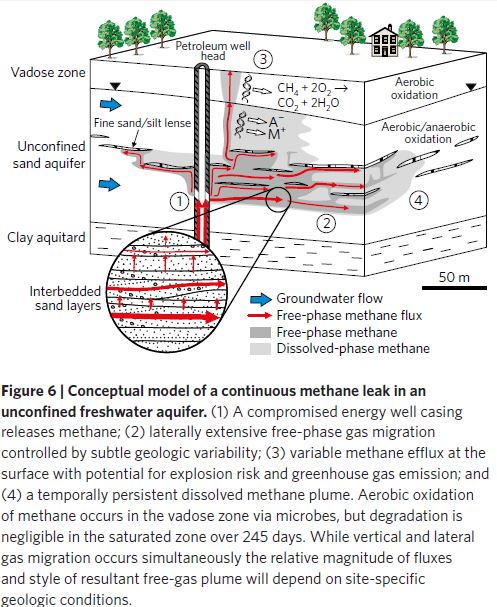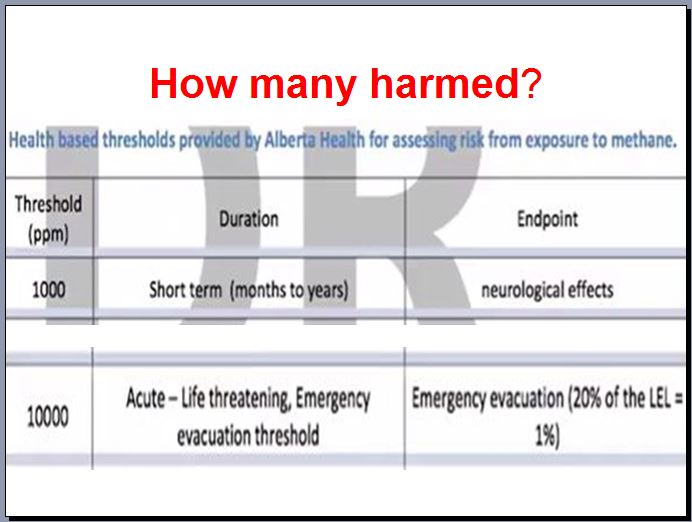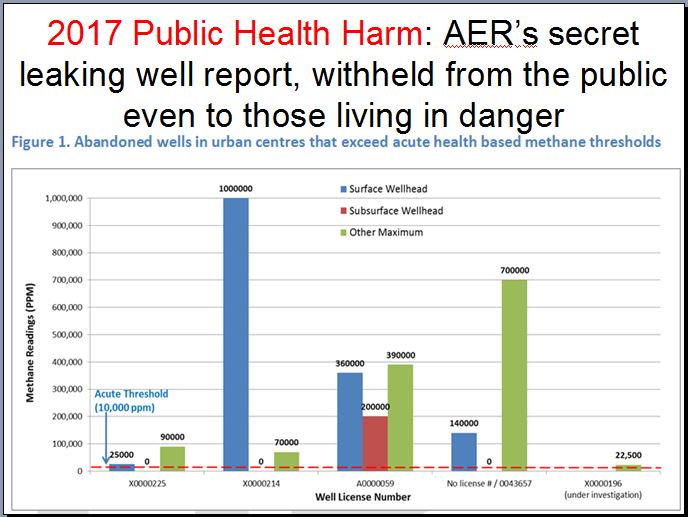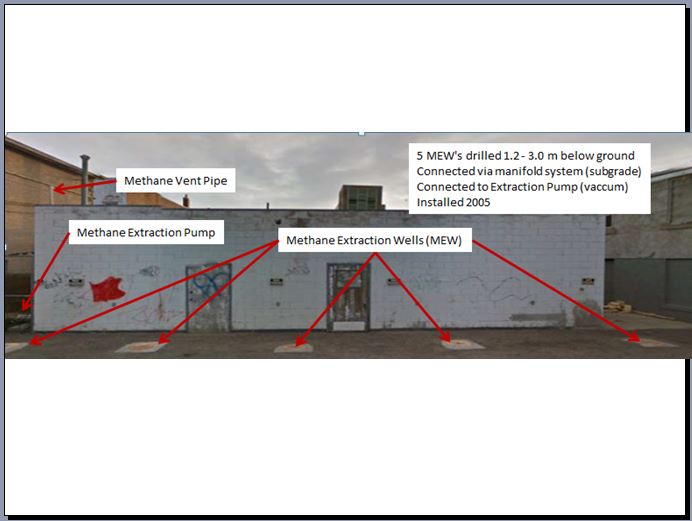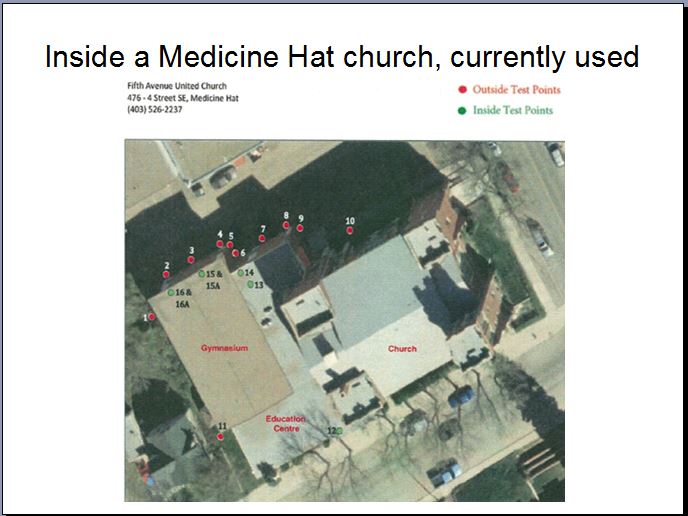Sour Gas damages the brain, even at very low levels:
1. Exposure to levels below 10 ppm permanently damage the human brain
2. Harm from levels below 10 ppm by Worksafe Alberta
3. Occupational Safety & Health Administration (OSHA) LOW LEVEL HEALTH HARM WARNINGS:
Sour Gas Concentration (ppm)/Symptoms/Effects
0.01-1.5 ppm/Odor threshold (when rotten egg smell is first noticeable to some). …
2-5 ppm/Prolonged exposure may cause nausea, tearing of the eyes, headaches or loss of sleep. Airway problems (bronchial constriction) in some asthma patients.
***
The Leaks that threaten the clean image of natural gas
Frac’ing shales in Ontario? Pink arrow shows approximate location of Lambton Shores
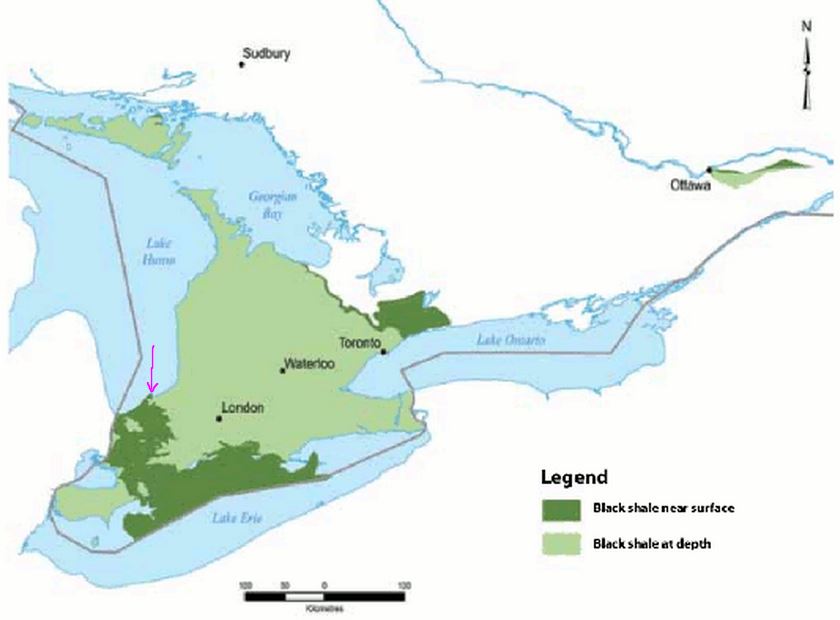
Yes, those are shales you see by Ottawa.
How long til the insatiable industry frac’s under the Supreme Court of Canada and Parliament?
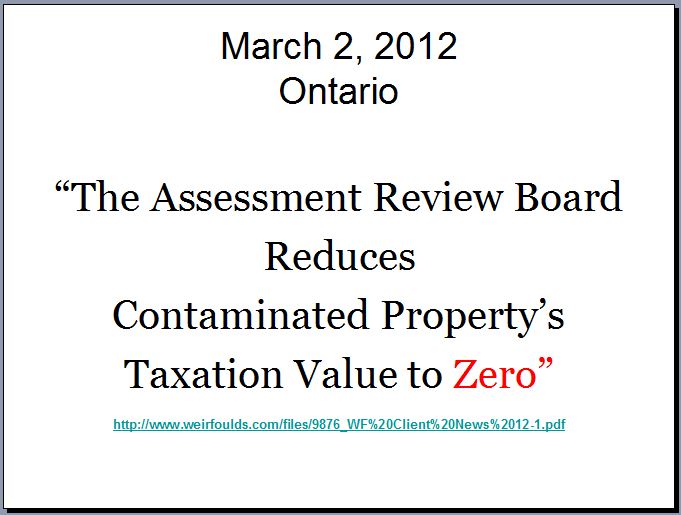

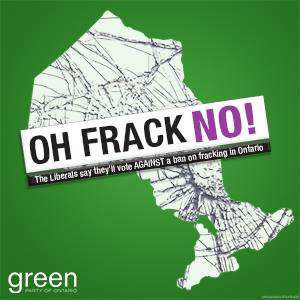
Doesn’t matter how any political party votes, industry is already frac’ing Ontario to hell and back: After 3,600 frac’d/stimulated wells in Ontario: Private member’s bill to ban high volume fracing passes second reading
Ontario Government Won’t Define High-Volume Fracking and Lies to the Public!
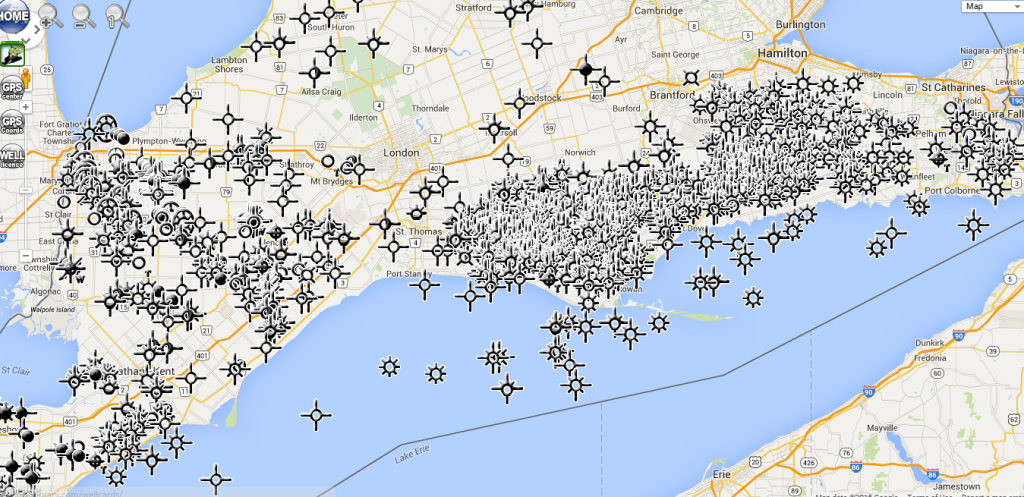
As of 2015, Ontario has “~3,600 records” for “Well treatments and stimulations (aka fracs). Includes details on the treatment type, treatment pressure, treatment volume, depth interval, and formation.”
***
Lethal gas leak in Norfolk forces evacuation of 22 homes by Hamilton Spectator, Aug 31, 2019
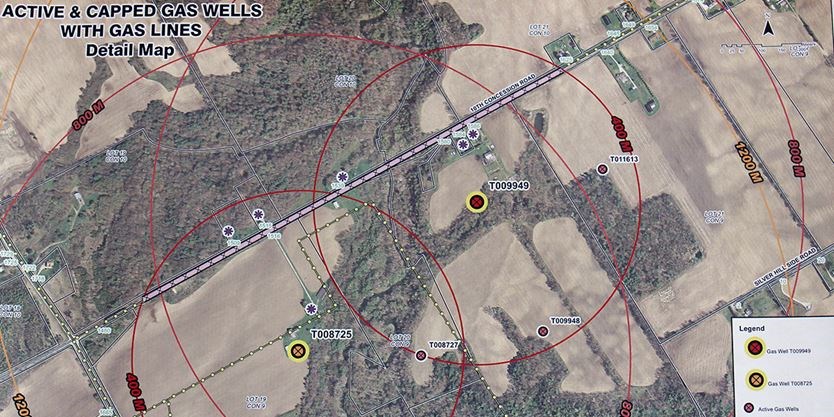
Map provided by Norfolk County
A gas well in Norfolk County that continutes to leak has prompted an order for 16 more homes in the area to be evacuated.
Last week, a well between Langton and Silver Hill began to leak hydrogen sulphide, a sour, flammable gas that can be lethal at high concentrations.
The local health unit originally ordered six homes to be evacuated, but increased that order Thursday to a total of 22 homes. The order would remain in place “until such time as sample results indicate safe levels in the affected area.”
The county has closed North Walsingham Concession 10 between Forestry Farm Road and East Quarterline Road. Sipprell/Riverside Cemetery, located at 1580 10th Concession in Langton, is also closed.
The Ministry of Natural Resources and Forestry is working to plug the leak, and the Ministry of Environment and Climate Change continues to monitor the air at the property. The fire marshal’s office is inspecting gas wells in the area.
Residents are asked to avoid the contaminated zone. “The public is strongly advised to stay outside of this zone, including hunters, recreational users, and passersby,” said the county in a media release.
A staff report presented to a special meeting of Norfolk County council indicated hydrogen sulphide (H2S) gas is colourless, toxic and flammable, formed as the result of bacterial breakdown of organic matter containing sulphur.
It occurs naturally in crude petroleum, natural gas and sour gasses and at low concentrations, has the odour of rotten eggs.
It can be detected at very low concentrations, but higher, potentially-dangerous levels may cause ‘olfactory fatigue,’ completely destroying a person’s ability to smell the gas.
The report states prolonged (several hours or days) exposure to concentrations as low as 50-100 parts per million (ppm) can cause a runny nose, cough, hoarseness and shortness of breath. Prolonged exposure to higher concentrations can produce bronchitis, pneumonia and a potentially fatal buildup of fluid in the lungs (pulmonary edema).
The report also included an H2S level of 56.8 ppm was recorded by the Office of the Fire Marshal mid-afternoon Friday, Aug. 25 near well T008725 and subsequently as high as 177 ppm.
The county has activated its emergency control group, which has established two 400-metre exclusion zones around the leaking well.
Firefighters test gas levels at every home by Monte Sonnenberg, August 30, 2017, Simcoe Reformer
JARVIS – Silver Hill isn’t the only community in the local area with a natural gas problem on its hands.
Last week – as Norfolk officials were fretting over a hydrogen sulphide leak southeast of Langton – the Haldimand County Fire Department was probing unusually high methane readings in downtown Jarvis.
Natural gas emissions in the Jarvis area are a well-known hazard with a long history. More than 100 years ago, Haldimand was dotted with gas derricks and was the major source of natural gas for homes, businesses and industries in the Hamilton area.
Buildings and barns in the Jarvis area have occasionally exploded and caught fire due to subterranean gas emissions. Haldimand’s gassy legacy is a known quantity and most every property in Jarvis monitors for it.
A natural gas explosion in Jarvis in 1991 prompted the former City of Nanticoke to declare an emergency and evacuate an area near the intersection of Highway 3 and Highway 6. Venting pipes with sensors were later installed in this part of town. It was here that higher-than-normal concentrations of methane were detected Monday, Aug. 21.
“We took a proactive approach and called the Ministry of Natural Resources & Forests, the Ministry of the Environment and the Fire Marshal to get more advanced equipment in to monitor,” Haldimand Fire Chief Jason Gallagher said Wednesday in an email.
“One business was closed as we had minimal readings in the business, which were not hazardous as this business has its own gas-detection system which was functioning and not in alarm mode.
“The business was re-opened within two hours of the initial closure.”
Haldimand County also drew up a pamphlet that was circulated to all homes and businesses in Jarvis. Haldimand firefighters performed manual gas readings at every home in Jarvis and answered any questions. All readings came back negative.
The county is working with local plumbing and heating contractors to provide in-home gas detectors to any Jarvis resident who needs one. [Ernst asked the Alberta regulator to supply such detectors to all citizens with dangerous levels of gases in their water wells after nearby frac’ing; Ranchers Ronalie and Shawn Campbell had dangerous levels of gases (with industrial fingerprints) in their water, including H2S. Alberta regulator refused.]
“We are continuing to monitor the situation, which has been the practice of the fire department for years,” Gallagher said. “Having said that, we are assessing the need for more permanent monitoring systems. There was never an emergency declared, nor was there a need to declare. It was a pro-active approach to ensure the public’s safety and have the proper government agencies involved.”
Six homes on North Walsingham Road 10 in Silver Hill have been served with evacuation orders due to higher than acceptable hydrogen sulphide readings at two gas wells in the neighbourhood.
A section of the concession road about a kilometre long has been barricaded and is off-limits to all vehicular traffic. Tuesday, Norfolk council hired the firm GHD to install sophisticated detection equipment in the affected zone for ongoing monitoring.
Like methane, hydrogen sulphide is a flammable, foul-smelling gas associated with natural gas deposits. Both are hazardous in high concentrations because they displace oxygen. Anyone breathing air thick with methane or hydrogen sulphide can die of asphyxiation as a result. [In Alberta, families with dangerously contaminated well water venting from their water taps were told, in writing by the regulator, that methane is perfectly safe]
Because of its sulphur content, hydrogen sulphide gas readily corrodes and degrades many metals.
Update on H2S Gas Leak Situation by Norfolkcounty.ca, August 28, 2017
The Norfolk County Taskforce continues to meet and respond to the situation surrounding the leak of Hydrogen Sulphide (H2S) from natural gas wells in an area between Silver Hill and Langton.
At high concentrations, humans lose the ability to smell Hydrogen Sulphide, which is
lethal and flammable, so the lack of a “rotten egg smell” in an area does not mean the
gas is not present. Conversely, “the rotten egg smell” can be present when
concentrations are at a level that does not pose a threat to human health.
Citizens who believe a well is leaking H2S should contact the Spills Action Centre of the
Ontario Ministry of Environment by calling 1-800-268-6060 (toll-free) or 416-325-3000.
Norfolk County has established an information resource titled “Risks of Hydrogen
Sulphide”, with assistance from the Haldimand & Norfolk Health Unit. …
Residents are urged to stay away from the areas identified along North Walsingham
Concession 10 between Forestry Farm Road and East Quarterline Road until further
notice. The road has been closed and six households have been ordered to evacuate
by the Medical Officer of Health. The Office of the Fire Marshall and the Ministry of
Environment and Climate Change continue to monitor gas levels in the area.
The exclusion zone also prohibits anyone from entering the area on foot, on any type of vehicle (farm tractors, 4WD trucks, all-terrain vehicles, bicycles, motorcycles, horses, etc.) or vessel (boats, canoes or kayaks on Big Creek). O.P.P. remain vigilant and continue to provide policing services to the affected area. …
Norfolk County wishes to thank the following agencies for their ongoing effort, support,
collaboration and service to the Norfolk community:
- Office of the Ontario Fire Marshall and Emergency Management
- Ministry of Natural Resource and Forestry
- Ministry of the Environment and Climate Change
- Ontario Provincial Police
- Ministry Health and Long-Term Care
- Public Health Ontario
… A Special Meeting of Norfolk County Council on Tuesday, August 29, 2017, at 3:00 pm,
has been called to review the situation and provide strategic decision-making with
respect to future implications.
Norfolk County Taskforce – Update on H2S Gas Leak Situation – PDF
Sour natural gas well in Langton area by Simcoe Reformer, August 19, 2017
LANGTON – Several households were evacuated near Langton on Friday following a natural gas leak in a rural neighbourhood.
This wasn’t a gas leak as most people understand them.
This leak didn’t involve a utility, a ruptured pipe or some sheepish backhoe operator who didn’t call before he dug.
Rather, this was a significant, sustained emission from a raw underground deposit.
Norfolk Mayor Charlie Luke reported Friday afternoon that the leak occurred in the area of 1586 North Walsingham Road 10.
After first responders arrived, the order was given to evacuate everyone within 400 metres of the leak.
The mayor reported that three households were evacuated and the concession road closed in the vicinity. The road was re-opened later in the day.
Officials representing the Haldimand-Norfolk Health Unit, the Ministry of the Environment and the Ministry of Natural Resources were notified.
“Their job is to gather data, measure it and determine health implications,” Luke said.
There are “significant levels of hydrogen sulfide (H2S) related to a gas well” at a property on 10 Concession Road, Langton, the health unit stated in a media release issued on Friday night.
Hydrogen sulfide smells like rotten eggs and at high levels can be flammable, said a fact sheet provided by the health unit.
“Health Unit staff are working with the appropriate property owners, County and Ministry officials to provide support towards the goal of having the issue addressed quickly,” said the release.
An event like this on the Norfolk Sand Plain is unusual. The soil on the sand plain is so light and porous that gases emanating from the earth rarely accumulate in sufficient concentrations to warrant attention.
This is in contrast to the heavy clay loam that serves as the foundation of Haldimand County.
In the 19th century and early 20th century, Haldimand was the epicentre of a natural gas industry that heated, lighted and powered major metropolitan areas such as Hamilton.
The easily-accessible deposits were exhausted long ago but the county is occasionally reminded of its natural gas past with significant emissions in urban areas.
The biggest evacuation of them all occurred in the 1990s in Jarvis. Following the accumulation of gas in a building downtown and a subsequent explosion, City of Nanticoke Mayor Rita Kalmbach declared a state of emergency and ordered an evacuation.
Today, residents of Jarvis are careful to ensure that their buildings, basements and crawl spaces are properly vented.
HYDROGEN SULFIDE FACTS (Source: Haldimand-Norfolk Health Unit)::
- Hydrogen sulfide often occurs naturally in some environments (gas wells, sulfur springs, swamps, etc.). It can also be associated with animal farms, industrial plants, sewers or sewage treatment plants.
- The release of hydrogen sulfide from a specific source does not always lead to human exposure. You can only be exposed to the gas when you come into direct contact with it by breathing it in, eating or drinking something contaminated with it, or when it touches your skin. Any absorbed hydrogen sulfide does not accumulate in the body as it is rapidly metabolized in the liver and excreted in the urine. Hydrogen sulfide usually breaks down in the air and therefore exposure is only likely to continue if there is an ongoing source.
- Exposure to low concentrations of hydrogen sulfide may cause irritation to the eyes, nose, or throat. It may also cause difficulty in breathing for some people with asthma. Low concentrations of hydrogen sulfide may cause headaches, poor memory, tiredness, and balance problems.
- Brief exposures to high concentrations of hydrogen sulfide (greater than 1000 ppm) can cause a loss of consciousness. In most cases, the person appears to regain consciousness without any other effects. However, in some individuals, there may be permanent or long-term effects such as headaches, poor attention span, poor memory, and poor motor function.
NOTE: Facts reprinted from What Is Hydrogen Sulfide?
Some historic explosive sour gas seeping into homes and water wells in the area:
The Jarvis gas release incident Manocha, J. by J. Manocha, 1992, Ontario Ministry of Natural Resources, London, ON (Canada), Thirty-first annual conference [of the] Ontario Petroleum Institute Inc
Abstract[en] On 26 September, 1991, large volumes of natural gas were observed to be leaking from two water wells in the Town of Jarvis. Gas and water were being ejected from a drilled water well, at which a subsequent gas explosion occurred. Measurements of gas concentrations indicated levels far in excess of the lower flammability limit at several locations. Electrical power and natural gas services were cut off, and residents were evacuated.
A state of emergency was declared, and gas was found to be flowing from water wells, around building foundations, and through other fractures in the ground.
By 27 September the volumes of gas had reduced substantially, and by 30 September all residents had returned to their homes and the state of emergency was cancelled. The emergency response, possible pathways of natural gas into the aquifer, and public relations are discussed. It is felt that the likelihood of a similar incident occurring in the future is high. 11 figs
Primary Subject NATURAL GAS (C5613)
Source: Ontario Petroleum Inst., Inc., Chatham, ON (Canada); 310 p; 1992; p. 1-25, Paper 16; 31. annual conference of the Ontario Petroleum Institute Inc; Niagara Falls (Canada); 28-30 Oct 1992; Available from OPI, 70 Talbot Rd S, Box 340, Lambeth, ON, CAN N0L 1S0 $40.00 CAN
Record TypeReportReport Number OPI–CE04500
Country of publication Canada
Descriptors (DEI) ACCIDENTS, EMERGENCY PLANS, EVACUATION, LEAKS, NATURAL GAS, ONTARIO
Descriptors (DEC) CANADA, DEVELOPED COUNTRIES, ENERGY SOURCES, FLUIDS, FOSSIL FUELS, FUEL GAS, FUELS, GAS FUELS, GASES, NORTH AMERICA
Reference Number 25066655
Related Record 25049706
***

Event Type: Fire
Residential Fatalities: Unknown
Place: Jarvis ON
Injured / Infected: 1
Event Date: September 26, 1991
Evacuated: 1300
Estimated Total Cost: Unknown
Comments Jarvis ON, September 26, 1991 by Canadian Disaster Database
1300 evacuated; 1 injured; a natural gas explosion destroyed one house; the owner of the home suffered burns from the blast; the explosion was caused by gas seeping into a backyard well; all natural gas lines were turned off; electricity and phone lines were shut off to prevent sparks from triggering more explosions in the area off the north shore of Lake Erie; the area had to be evacuated; the evacuation lasted 4 days.
No wonder homes are exploding! Look at the energy wells in that area. Reportedly, companies are drilling and frac’ing under Lake Erie now too.

As of 2015, Ontario has “~3,600 records” for “Well treatments and stimulations (aka fracs). Includes details on the treatment type, treatment pressure, treatment volume, depth interval, and formation.”
***
Alberta’s “World-Class” AER’s response to critical industrially caused sour gas events?
CANADA’S FEDERAL GOVERNMENT’S RESPONSE TO THESE DEADLY WIDESPREAD INDUSTRY-CAUSED EMERGENCIES, EVACUATIONS, EXCLUSION ZONES, THAT INCLUDE FATALITIES AND HOME EXPLOSIONS:
Ottawa plans to declare deadly gas is non-toxic by Elizabeth McSheffrey, December 21, 2017, National Observer
A corrosive gas that is fatal to humans in high concentrations is a non-toxic substance under Canadian environmental law, say federal researchers in a new proposal.
Staff at Health Canada and Environment and Climate Change Canada came to this conclusion in a draft assessment of hydrogen sulfide, published in September. The proposal found that the gas, also known as H2S or sour gas, does not enter the environment in quantities, concentrations or conditions “that constitute or may constitute a danger in Canada to human life or health.”
Their conclusion is at odds with the substance’s track record — in the last five years alone, H2S has killed at least one oilpatch worker, sickened dozens of others and left livestock dead in a pasture in a small corner of Saskatchewan.
Sour gas, known for its trademark rotten egg smell, is commonly found in hot springs, volcanic gases and biological waste, but can also leak from the wellheads, tanks, pipes and flare stacks of the oilfields. That’s where most egregious, high-concentration encounters tend to occur.
National Observer, the Toronto Star and Global News compiled a list of oil and gas industry run-ins with H2S that resulted in injury or death in a series of special reports published in October.
According to the federal proposal however, such industrial releases aren’t representative of ambient conditions in Canada, and therefore “not considered relevant” in an assessment of H2S under the Canadian Environmental Protection Act (CEPA). If the government approves the draft proposal next year, it means Ottawa will not have the authority to write new codes of practice, management programs or legally-binding safety rules to regulate the gas under CEPA. [Canadian gov’t refuses to implement CEPA so its useless anyways. Ernst begged for it to be implemented in her 2007 testimony to Parlimentary committee. All she got were shrugs, and comments from committee members afterwards that it’s normal business practice in Canada to let industry do what they want and get away with causing harm to environment and people]
In emailed comments, a Health Canada spokeswoman said that “occupational exposure falls under provincial jurisdiction,” and is not included in general population risk assessments under CEPA. [Even after entire towns are evacuated.]
“Provincial Jurisdiction” Reality Check:
A coalition of scientists, lawyers, doctors and environmental advocates, however, is concerned with that interpretation. The government “has failed to adopt a science-based, precautionary approach” to assessing H2S health risks in Canada, they wrote in a captious letter sent to Environment Canada during the H2S proposal’s public commentary period last month.
The plan doesn’t sit well with the victims of H2S exposure either — Jeff Crawford, a former oilfield worker who lives with permanent disability as a result of the gas, called the non-toxic assessment “incredible.” Crawford was hit in the face by a mixture containing H2S on the job in 2014, and today, suffers from PTSD, anxiety, dizziness and difficulty with eating, breathing, speaking, smelling and sleeping.
“It’s like saying cancer is not a disease,” he said in an interview. “I’d like them to sit in front of me and tell me they’re doing that. I’d tell them what I think about it.”

Industrial releases considered irrelevant
According to the federal researchers, the risk of encountering harmful concentrations of H2S in Canadian air or water is low. High-concentration industrial releases can cause pulmonary edema and severe neurological effects, they note, but such concentrations are “several orders of magnitude higher” than those encountered in a “community setting,” and therefore not considered a relevant measure of risk for the general population.
A joint media investigation published by National Observer, The Toronto Star, and Global News, however, has uncovered harmful encounters with sour gas that occurred outside of the oilpatch and in residential settings. In October 2012, for example, a teenager drove through a toxic plume of H2S outside a relative’s home in southeastern Saskatchewan, and immediately started vomiting. The youngster missed school for several days.
Even if dangerous concentrations waft into communities as a result of an oilpatch accident, Health Canada says it does not factor them into assessments under CEPA.
Health Canada Reality Check: Why was a 2012 Health Canada Report, admitting significant health hazards and risks to groundwater and air from hydraulic fracturing, kept from the public?
“Health Canada does not consider industrial incidents like accidental spills or emergency situations in its assessments, even if they could result in off-site exposure that could impact the general population,” said the department in response to emailed questions. “Its assessments focus on releases that occur during normal operating conditions rather than exceptional circumstances.”
The department will consider spills or emergency situations in risk assessments, it added, if they occur so frequently that they form part of “normal” operations.
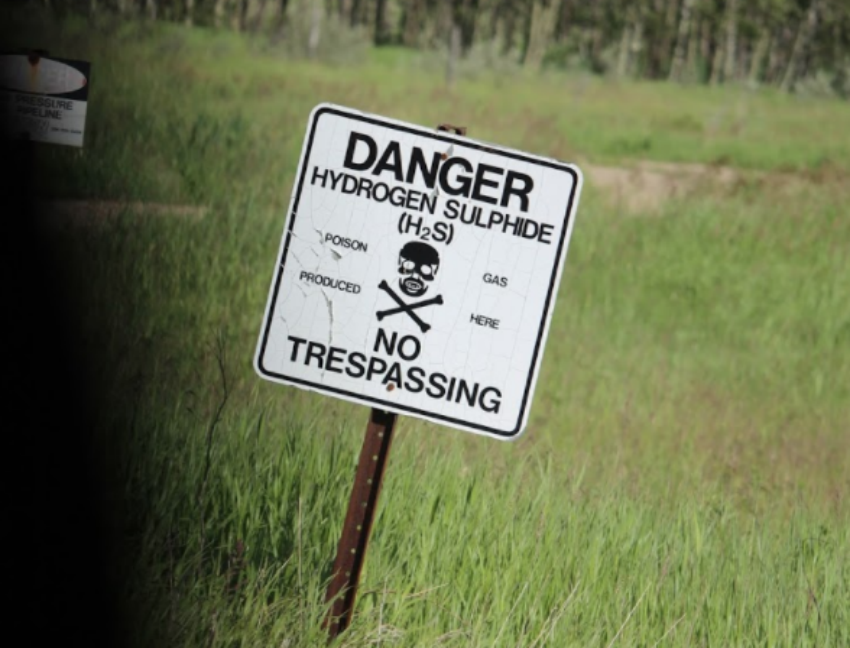
Hydrogen sulfide, Health Canada noted, is already subject to a number of provincial, territorial and federal regulations on emergencies, hazardous materials, environmental and air quality, and occupational health and safety. Those include three existing measures under CEPA, which would remain in effect if Ottawa declined to list the substance as toxic. [Impossible! CEPA has not been implemented by the feds! It’s useless.]
Additional monitoring, inspection, data collection and measurement takes place within the oilpatch to protect workers and the public from rogue H2S emissions that may find their way into unwary communities.
But industry doesn’t always follow those rules, found the media investigation, conducted in partnership with journalism schools at the universities of Concordia, Regina, Ryerson and British Columbia, the Michener Awards Foundation and Corporate Mapping Project.
Dozens of H2S infractions have been recorded in Saskatchewan over the last five years. Both industry and the provincial government were aware that H2S leaks were taking place across multiple oilfield operations at the time, the investigation learned, but declined to issue any additional public safety warnings as a result of the incidents.
In 2014, oilpatch worker Michael Bunz died on the job after a tank valve burst in southeastern Saskatchewan, spraying oil, water and H2S in his face.
Health Minister Ginette Petitpas Taylor and her department did not respond to questions about whether the federal government should crack down on H2S releases in response to concerns about weak provincial oversight.
Charges have been laid against Bunz’s employer, Nalco Champion, under occupational health and safety legislation for failing to provide him with a respirator and ensure he entered a dangerous situation with a second worker on the day he died from sour gas exposure.
Asked about the federal proposal to rule that H2S, the substance that killed her son, is non-toxic and doesn’t require additional federal safety measures, Dianne Bunz suggested that public safety may not be the primary motivation.
“Look at all the sites that have failed their H2S tests,” she told the investigation. “Not just a little bit — an alarming amount, enough to kill people. And they want to remove it? I find that strange. I don’t know why they would do that. Cost probably — no one wants to pay for all of this extra safety stuff.”
Dianne and Allan Bunz speak about the death of their son Michael, who was killed on the job by H2S. Video by National Observer with footage courtesy of Global News and the University of Regina School of Journalism
Like reading that water ‘isn’t wet’
Critics of the federal H2S proposal argue that industrial encounters like Bunz’s should not be overlooked by the federal government. “The frequency and seriousness” of sour gas releases “indicates the need for greater regulatory oversight” than currently exists, argue Ecojustice, the Environmental Law Association, Environmental Defence, Prevent Cancer Now and the Canadian Association of Physicians for the Environment.
More evidence of lack of provincial jurisdiction: Prevent Cancer Now calls out AER’s Health Fraud! “The AER has no jurisdiction for human health, and Alberta is famed for a chill against the medical community linking ill health to petrochemicals.”
CEPA requires the federal government to regulate any substance that “may enter the environment” in quantities, concentrations or conditions that “may constitute a danger” to human life or health. It does not say anywhere in the legislation that industrial incidents and workplace exposure cannot be considered under the act. [The act remains useless because the feds refuse to implement it]
A 1997 ruling in the Supreme Court of Canada further confirmed that federal action to protect the public from toxic substances does not interfere with provincial powers. The split 5-4 decision was related to the dumping of toxic polychlorinated biphenyls by Hydro-Québec, but it had broader implications confirming that CEPA was valid and constituted criminal law. [CEPA might be valid, but if not implemented, it remains useless, likely intentionally to keep polluting and illegal aquifer frac’ing oil and gas companies happy and donating to greedy political pockets]
“The protection of the environment, through prohibitions against toxic substances, constitutes a wholly legitimate public objective in the exercise of the criminal law power,” said the majority decision, written by Gérard La Forest.
“Protection of the environment is an international problem that requires action by governments at all levels. The legitimate use of the criminal law in no way constitutes an encroachment on provincial legislative power, though it may affect matters falling within the latter’s ambit.”
Twenty years later, in the case of hydrogen sulfide, Joseph Castrilli, legal counsel for the Canadian Environmental Law Association, agreed. He said both provincial regulation and any new federal regulation of the substance under CEPA “can live together” simply enough — industry would just have to comply with the most stringent of the two standards.
“The only limitation of provincial law is that if there are two regulations that basically deal with the same subject matter, then the provincial regulation can only be more stringent than the federal one,” he said in an interview.
If the federal government ruled that H2S were toxic under CEPA, Castrilli added, it could also create a number of non-regulatory measures to improve public safety, including risk management programs and voluntary codes of practice, that wouldn’t step on any provincial toes.
That’s what makes the federal government’s proposal such a mystery, say the environmental, health and legal groups in their letter. What’s the harm in ruling H2S as toxic?
Industry Profits Reality Check: 2017 July, New Study: Sulfide-producing bacteria dominate hydraulically fractured shale oil & gas wells. “An estimated 70% of waterflooded reservoirs world-wide have soured.”
Guess who waterfloods the reservoirs.
“That H2S is toxic should be beyond debate,” it reads. “It is plain that releases of H2S may occur as a result of oil and gas operations… It is equally plain that a release may constitute a danger in Canada to human life or health.”
The federal proposal — while not yet finalized — also dismisses H2S’s rotten smell as a “nuisance,” without “scientific or legal justification,” it argues, and did not base its decision on the very lowest H2S exposures that are known to cause adverse health effects to humans.
Its focus on the general population, the groups say, also fails to consider vulnerable communities living near industrial operations, whose quality of life may be compromised by constant odours or even endangered in the event of a leak or spill.
More provincial “jurisdiction” reality check: MUST READ Diana Daunheimer: Alberta Energy Regulator should be ashamed, AER Directive 60 Deregulation as the frac poisons ramp up
“It’s kind of like reading that water isn’t wet,” said Elaine MacDonald, an environmental engineer at Ecojustice and director of its healthy communities program.
“That’s why we decided to write the letter. We couldn’t let it go… This is probably close to a 10 out of 10 in terms of ignoring the evidence.”
Science Minister Kirsty Duncan declined to comment on whether the federal proposal was evidence and science-based, and requests for comment from Environment Canada on human health and sour gas were referred to the health department.
Health Minister Ginette Petitpas Taylor, who conducted the draft assessment in partnership with the environment minister, did not respond directly to written questions, but issued the following statement via email:
“Canada’s Chemicals Management Plan is a world-leading program that is contributing towards the global goal of sound management of chemicals. In Canada, hydrogen sulfide is subject to a number of risk management measures, which are included in provincial and territorial regulations and guidelines for air quality, including the control of releases from industry.”
“World-Leading” Reality Check
Like this comment by annie_fiftyseven to Nikiforuk’s article on Ernst’s lawyers quitting her lawsuit?
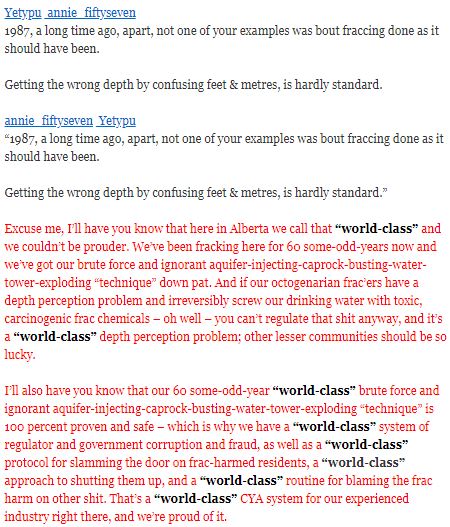
Federal plan acknowledges data shortfalls
According to Health Canada, it’s not “unusual” for an assessment under CEPA to rule that a substance with highly hazardous properties is non-toxic. In May 2016, for example, the federal government determined that a group of azo dyes — known carcinogens — were non-toxic, since their exposure to people is very low, or non-existent.
But there are data gaps in their assessment of human health and H2S, wrote the researchers who submitted the draft assessment for sour gas. Long-term chronic experimental studies on the gas’s impact on human health are either limited or non-existent, the proposal notes, as is data on industrial releases in certain sectors (metal and metal refining, for example) located close to human populations. Researchers did however, access and consider decades of hourly H2S measurements taken in the air [UPWIND OF?] near pulp and paper mills, oil and gas fields, livestock farms and more.
The federal government said the assessment also considered exposure to people who live near industrial facilities, but that “focus on general population exposure,” has been its practice since the inception of the Chemicals Management Program — a sweeping evaluation of more than 4,000 chemical substances under CEPA with a deadline of March 2021.
That evaluation takes place as the federal government deliberates changes to the aging legislation, which has not been updated since 1999. A June 2017 report by the Standing Committee on Environment and Sustainable Development identified several key “weaknesses” in CEPA’s regulatory framework, and made a number of recommendations that could impact what kind information it considers in assessments. Several of them include special consideration for “vulnerable communities,” like those living in close proximity to industry operations.
The federal government has said it will respond to those recommendations before June 2018. But to rule on H2S while the entire act is called into question is “definitely irresponsible,” said former corporate lawyer and environmental law expert Jason MacLean.
“It looks like a decision that’s irrational and negligent on its face and it looks even worse I think to be doing this while (CEPA) is under consideration,” the assistant law professor at University of Saskatchewan, told the investigation. “It looks hasty, it looks rushed, and that’s not in the public interest.”
If the federal plan is approved however, and someone gets sick from ambient exposure to H2S, MacLean said it would be “an uphill battle” to try and sue the federal government for its ruling that the substance isn’t toxic under CEPA. One would have to prove that Ottawa was negligent and “flying in the face of independent scientific findings” in its chemicals assessment, he explained, but “any amount of legitimate scientific doubt” to those claims could probably take the case apart in the courts. [AND THEN THERE’S THE SERIOUS INTENTIONALLY DESIGNED PROBLEM OF LACK OF ACCESS TO “JUSTICE” IN CANADA, FOR NEARLY ALL CIVIL CANADIANS!]
Independent scientist backs assessment
Geoff Granville, a Calgary-based scientist with expertise on managing the risks of toxic substances, said in an interview that he agrees with the government’s draft assessment of H2S. People in a non-occupational setting are not usually at risk, he explained, and if an incident does occur outside of the workplace, it may be accidental with unknown or extraordinary causes.
That’s tough for the federal government to regulate preemptively, said Granville, and not within the scope of CEPA: “It’s not (about) risk based on an accident situation, otherwise cars are toxic. That makes no sense. It’s not accident driven, it’s got to be by the way the world operates.”
Encounters based on industrial and workplace exposure, he added, are another matter entirely. Bad industry practice is unacceptable, said Granville, but since most industry regulation falls within the jurisdiction of provincial regulators and governments [SURELY HE MEANS “DEREGULATION!], it may be more practical for Ottawa to find other methods of encouraging adherence to H2S regulations than cracking down with the full force of CEPA.
The question then becomes, said Granville, what more can the federal government do to protect public safety?
He suggested co-operation between jurisdictions to help address people’s “very natural” fear of H2S, like strengthening whistleblower programs or starting a conversation about how to handle to low, foul-smelling but ultimately not dangerous levels of H2S. In the context of CEPA, he said the word ‘toxic’ takes on a legal meaning of its own, and much of the outrage with the federal plan has to do with semantics.
“So how do the feds shame a provincial environmental ministry to step up and really regulate and do its job better?” he asked. “Whether you call it toxic or not, I actually think the feds could say, ‘We’re concerned about low levels of exposure to the public, which does happen, and therefore, we’re willing to prepare something to work with other jurisdictions and do x, y, z.”
The government’s assessment isn’t final, and while the public commentary period has officially closed, Health Canada is encouraging stakeholders to submit “any additional information that should be taken into consideration.” In conjunction with Environment Canada, the department will publish a summary of public commentary on its proposal, its responses to those comments, and its final assessment of H2S in 2018.
A comment to the article:
Nielle Hawkwood
The old excuse of “not dangerous under normal operating conditions” is a well-used copout for Government and industry. “Normal operating conditions” is ill-defined. How many times do “emergencies” have to occur before they become part of normal operations? How many people living in rural areas near fracking and other heavy industrial facilities have to be made ill before it is realized that ignoring these occurrences is discriminatory treatment?
Refer also to:
How do they know if Ministry of Natural Resources doesn’t have records or locations for 23,000 – 30,000 oil and gas wells drilled in Ontario, and can’t or won’t define “high volume hydraulic fracturing?”
The ground in Sarnia and Lambton County is home to a significant number of salt caverns and depleted wells used by the chemical and energy industry to store natural gas, other hydrocarbons and liquified petrochemicals.
This storage is a largely unseen but significant resource for industry in Sarnia-Lambton, and other regions. …
In June 2015, Lambton Shores officials declared a localized state of emergency after geysers of natural gas blew out of a creek at the Indian Hills Golf Course.
It was determined to a naturally occurring event, since there were no pipelines in the area, and no other man-made sources for the gas found.
[Honesty Check:
Pink is abandoned energy well near the Indian Hills geysers
Blue is an industry gas well (black are other energy wells)
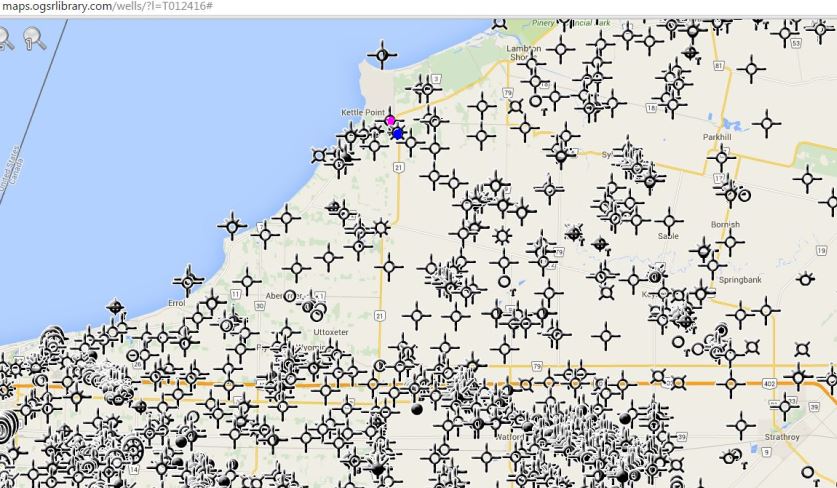
Was the industry gas well (blue dot) near the Indian Hills gas geysers frac’d or refrac’d, or others nearby frac’d/refrac’d?
End Honesty Check ]
Environmental causes of childhood cancers ‘grossly underestimated.’ In Canada, toxic chemicals used by oil and gas industry are exempt under CEPA (1999)
CEPA, Canada’s main environmental law isn’t working. Of course it isn’t, the oil and gas industry is largely exempt while emissions of the most harmful chemicals are on the rise. Live in a frac field? Hold your breath, don’t drink the water.
Investigators say an accumulation of gases appears to have caused the explosion that destroyed the Rosebud water tower and sent a Wheatland County employee to hospital
To Honour the Fallen on Remembrance Day: Make public AER’s secret “D79 Abandoned Well Methane Toxicity Preliminary Assessment” & Appendix 2 by Alberta Health, Admitting “Acute-Life threatening” risks & “Neurological effects” [Rural towns and hamlets in Alberta were not included in this “assessment”]

AER’s report which the regulator is still keeping secret. The AER (100% industry funded, controlled & led) and Alberta Health are not even distributing it to the families the authorities know are living in explosive and or toxic risk caused by industry’s leaking gases venting near and or into homes, businesses, parking lots, streets, schools, billion dollar airport expansion and churches.
Or, click on the links below:
Alberta Health’s ‘Methane from Leaking Abandoned Wells Health and Safety Issues’ is dreadfully incomplete and shoddily pathetic, but admits methane’s harmful health effects:
Note the red dotted line in graph above: “Acute-Life Threatening, Emergency Evacuation Threshold”
Slides above and below from Ernst’s 2017 speaking tour in England & Northern Ireland
Medicine Hat, AB Malcolm Canneries Gas Explosion, Mar 1913, Alberta Explosions, City’s deadliest industrial accident, 100 years later by Collin Gallant, March 16, 2013, Medicine Hat News
That Medicine Hat had all hell for a basement was self-evident at the turn of the last century. Cheap and available natural gas was the main selling point for early city fathers in luring industry to the burgeoning town. But, as obvious as the advantages were, so too were the dangers.
Pockets of gas escaping relatively crude wells and piping systems would regularly catch fire, burning homes and businesses, but few were prepared for what transpired on the afternoon of March 19, 1913.
The explosion at the Malcolm Canneries, still the deadliest industrial accident in the city’s history, will be remembered in a set of special ceremonies on Tuesday.
“I think it was a very large surprise for everyone, especially the firefighters; nobody had ever envisioned that there could be an explosion of that magnitude,” said Wayne Lust, a 33-year-veteran firefighter and historian for the Medicine Hat Fire Service.
Having pieced together that day from eye witness accounts published in the News, as well as details of an inquest, Lust believes the event was a catalyst for the fire service. It quickly moved to build two more stations, the third and fourth in a town of 10,000, and modernize with motorized engines.
The early days of the department are dotted with buildings destroyed by relatively minor gas explosions, chronicled by Lust and colleague Gerald Rayner in the department’s official history book.
“It was quite common for a businessman to walk into his shop in the morning, turn on the gas lamp and blow up the building,” said Lust.
The explosion at the cannery, however, was an eyeopener.
Five were left dead, including three firemen and two onlookers, when a massive collection of gas ignited and brought the walls of the vacant abattoir down upon them. Twelve others were hit by flying bricks and were hospitalized.
A city engineer inside was left alive but trapped between flattened joists. Another engineer, stationed at the gas main outside the huge building, miraculously survived after he was flung 60 feet. The man he was helping, Jonathan Brier, a volunteer fireman and city gas worker, was found crushed at the shutoff.
Over the years Brier’s grave has been lost but on Tuesday a fire service honour guard will visit the final resting places of two other firemen, Reginald Rimmer and William Stewart. Members of Stewart’s extended family will attend the private service, then join the public at the Firefighters’ Memorial at Fire Station No. 3 for an 11 a.m. ceremony.
“It’s a recognition of the fact that they paid the ultimate price,” said Fire Chief Brian Stauth. “It’s a chance to remember the sacrifice they made and remind us that this can indeed be a dangerous occupation.”
Lust is currently piecing together the story so the names can be added to the national firefighter’s memorial in Ottawa.
Records from the era are incomplete but he believes gas began to track back into the building through a wooden sewer pipe running past an nearby well.
The building, which stood beyond the right-field fence of the present day Athletic Park, was originally built as a woolen mill but was being refitted to pack beef.
On the tragic afternoon a caretaker lit his pipe and saw flames flicker along the walls of the ground floor.
A fire crew extinguished the initial blaze, then began searching for the gas source by cutting through the floor with an axe.
Lust says according to an inquest held shortly after, the men found flames on the sewer pipe and cut into it to douse the source. Instead they felt a rush of gas as they broke in.
Men turned to run or cover up.
A police sergeant who was standing guard at the door testified that he saw men rush towards him but a moment later the building was completely destroyed.
The top two storeys seemingly vaporized as they lifted up three feet, according to witnesses, then collapsed inward.
“They (the firemen) actually saw the flame being pushed back down the hole that’s when the explosion happened,” said Lust.
“You read about walls flying, people thrown 60 feet, but no one was actually injured due to burns or the fire.”
Also killed on the day was 12-year-old Harry Green, who was watching the firemen work through a window when the gas touched off. His mates at Montreal Street School collected $21 a princely sum in 1913 to buy a funeral bouquet. F.C. Bohannan, a Boston native, was site-seeing when the fire broke out and was struck by debris.
“You have to think about Medicine Hat at the turn of the last century,” said David
Panabaker, general manager of the gas utility. “The place was booming. There were people drilling wells all over town, and the question is how you maintain safety.”
The query was partially answered by the city in 1902, said Panabaker, when it moved to gain control over all gas production and distribution, but old, abandoned and badly capped wells remained.
“The reality at the time was there was no regulation,” said Panabaker.
“At that time if you owned a house with a yard you may well have been able to drill a well.”
Those days are long gone.
Also to consider, he said, early wells would have had pressure 10 times greater than today, and gas would not have been treated with mercaptan, which gives gas a distinct rotten egg smell.
“You basically had high-pressure odourless gas floating around the neighbourhoods,” said Panabaker. “Obviously it’s dangerous and I can’t imagine what it would have been like, quite frankly.”
Calgary wants control over contaminated sites (1,766 known in the city!): “Oftentimes the authority is not aligned with the ability.” AER & industry set taxpayers up to be hung with $300 Billion in oilfield liabilities. Enabled by the courts?
“For larger leaks over longer times and greater areas, these findings would indicate that the groundwater would become unusable,” he said.
Leaky wells could pose a significant danger to the environment in a number of ways, said Cahill, who is now at the University of British Columbia.
“Methane is 30 times more potent than carbon dioxide at trapping heat when in the atmosphere, so we need to consider both the air and the groundwater when monitoring for leaks. The impact to groundwater is likely to be long-term and persist long after a methane leak is fixed,” he said. [Emphasis added]

